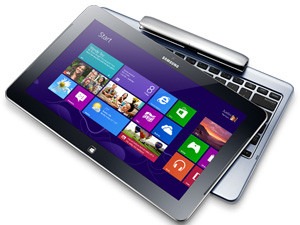
Samsung is aiming high with Windows 8, as it wants to use the new platform to propel itself into the PC industry big leagues.
The South Korean manufacturer unveiled its line-up of Windows 8 ultrabooks, notebooks, tablets, all-in-one PCs and hybrids in the US this week, and made clear its intention to break into the top five PC vendors by 2015.
While Samsung has been identified as one of the fastest growing PC vendors, it still has some significant ground to make up in the space. A recent report by Gartner showed Lenovo currently tops worldwide PC vendor shipments, with 15.7% market share, followed very closely by HP at 15.5%. Samsung currently only falls into the 'other' category in terms of global shipment market share, well behind Dell, Acer and Asus.
Samsung is pushing the concept of the 'Smart PC' which is essentially the new category of a PC/tablet hybrid which leverages the touch capabilities of Windows 8. While Samsung had already unveiled some of its hybrid Windows 8 devices, they have now been rebranded as 'ATIV Smart PCs'.
Samsung America consumer electronics head, Tim Baxter, says: "Tablets and smartphones are ushering in a new era of computing mobility. New categories will arise as a result of this."
"ATIV Smart PC combines the power of a notebook PC and the convenience of the media tablet," says Samsung, adding that the range is designed specifically for Windows 8 and gives users the full PC experience.
The ATIV Smart PC currently has two models, the Pro 700 T and the 500T. The entry-level 500T has been given a US price point of $749, and features the S-pen stylus, five-finger touch capacity, an Intel Atom processor, 2GB RAM and an 11.6-inch display. The 500T can also be bought without the detachable keyboard for $650.
The higher level Pro 700T has the same 11.6-inch display but has 10-finger touch, an Intel Core i5 processor, 4GB of RAM, and is priced at $1 199.
Other products revealed by Samsung include the Series 5 'Ultra Touch' notebook - Samsung's first 10-finger multi-touch notebook - and the Windows 8 version of the Series 9 Premium Ultrabook (starting at $1 300 for the 13-inch model), Series 7 Notebook ($1 100) and Series 3 Notebook (starting at $450).
Samsung also showed off a new Series 5, 21-inch all-in-one desktop with touch capabilities, which will retail for $800. The Series 7 all-in-ones will have both touch and gesture recognition, and will come in 23.6-inch and 27-inch models for $1 100 and $1 700 respectively.
Careful positioning
Samsung did not showcase any of its tablets running Windows RT and will not as yet bring those devices to market, reportedly because the company is still deciding how to best position and target such products without confusing consumers.
While Samsung also produces Android tablets, the company says it will position Windows 8 tablets differently. Mashable quotes Samsung's senior vice-president of consumer marketing in the US, Mike Abary, as saying: "We want to position Android tablets as more of a living-room complementary device. What that means is that there's tablet-to-TV capability - the transfer of content between devices. With a Windows 8 tablet, that consumer has a multitude of different utilisation options on that device."
Windows 8 has also been the catalyst for a litany of new devices from other manufacturers, including Toshiba, Asus and Dell. Toshiba's Satellite U925t Ultrabook convertible has a 12.5-inch HD touch-screen display that can slide over the keyboard to function as a tablet. Asus has also revealed the Taichi ultrabook which features an ambitious double-sided display.
The first Windows 8 devices will become available in stores and online on 26 October, to coincide with official release of Windows 8.
Share